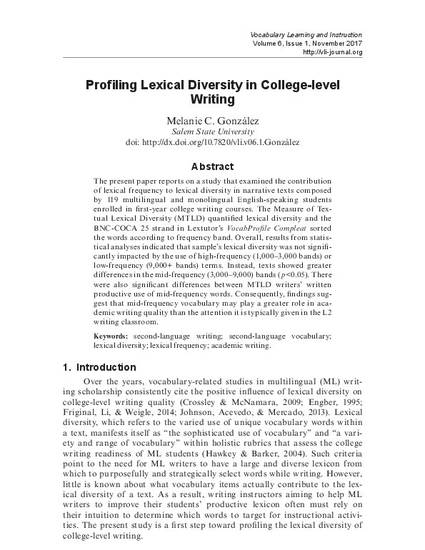
Article
Profiling Lexical Diversity In College-Level Writing
Vocabulary Learning and Instruction
(2017)
Abstract
The present paper reports on a study that examined the contribution of lexical frequency to lexical diversity in narrative texts composed by 119 multilingual and monolingual English-speaking students enrolled in first-year college writing courses. The Measure of Textual Lexical Diversity (MTLD) quantified lexical diversity and the BNC-COCA 25 strand in Lextutor’s VocabProfile Compleat sorted the words according to frequency band. Overall, results from statistical analyses indicated that sample’s lexical diversity was not significantly impacted by the use of high-frequency (1,000–3,000 bands) or low-frequency (9,000+ bands) terms. Instead, texts showed greater differences in the mid-frequency (3,000–9,000) bands (p<0.05). There were also significant differences between MTLD writers’ written productive use of mid-frequency words. Consequently, findings suggest that mid-frequency vocabulary may play a greater role in academic writing quality than the attention it is typically given in the L2 writing classroom.
Keywords
- second-language writing,
- second-language vocabulary,
- lexical diversity,
- lexical frequency,
- academic writing
Disciplines
Publication Date
November, 2017
Citation Information
Melanie C. González. "Profiling Lexical Diversity In College-Level Writing" Vocabulary Learning and Instruction Vol. 6 Iss. 1 (2017) p. 61 - 74 Available at: http://works.bepress.com/melanie-gonzalez/7/
